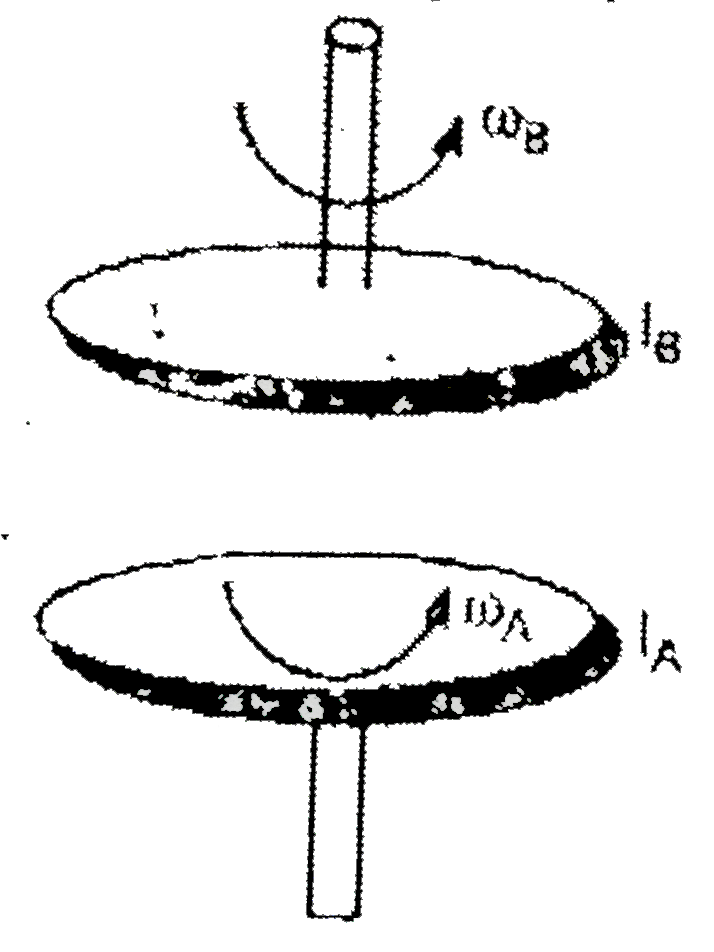Two coaxial discs, having moments of inertie I1 and I12 are rotating with respective angular volecities ω1 and ω12, about their common axis.They are brought in contact with each other and thereafter they rotate with a common angular volecity.If Ef and Ei are the final and initial total energies, then (Ef−E1) is:
−I1ω2112
−I1ω216
38I1ω21
−I1ω2124
The correct Answer is:C
Step by step video, text & image solution for Two coaxial discs, having moments of inertie I_1 and I_1/2 are rotating with respective angular volecities omega_1 and (omega1)/2, about their common axis.They are brought in contact with each other and thereafter they rotate with a common angular volecity.If E_f and E_i are the final and initial total energies, then (E_f-E_1) is: by Physics experts to help you in doubts & scoring excellent marks in Class 12 exams.
Updated on:21/07/2023Topper's Solved these Questions
Similar Questions
A clutch assembly consists of two discs A and B of moment of inertia 2I and I respectively, one being the engine fly wheel, the other one is the clutch plate. The discs are initially rotaing with angular velocities ωA=ω and ωB=2ω as shown in fig. When the two disc are brought into contact the discs rub against each other and eventually reach a common angualr velocity ω.
(a) Derive an expressio for ω
(b) What is the angular impulse of friction on any one of the discs?

View SolutionTwo bodies with moment of inertia l1 and l2 (l1>l2) have equal angular momentum. If E1 and E2 are the rotational kinetic energies, then
View Solution
Knowledge Check
Two coaxial discs, having moments of inertia l1andI12 are rotating with respective angular velocities ωandω12 about their common axis. They are brought in contact with each other and thereafter they rotate with a common angular velocity. If EfandEi are the final and initial total energies, then (Ef−Ei) is:
A−I1ω2112BI1ω216C38I1ω21D−I1ω2124Two coaxial discs, having moment of inertia I1 and I12, are rotating with respective angular velocities. ω1 and ω12, about their common axis. They are brought in contact with each other thereafter they rotate with a constant angular velocity. If Ef and Ei are the final and initial total energies, then (Ef−Ei) is:
A−I1ω2124B−I1ω2112C38I1ω21D16I1ω21Two bodies with moment of inertia I1 and I2(I2>I1) are rotating with same angular momentum. If K1 and K2 are their K.E.s, then
AK2>K1BK2<K1CK1=K2DK2≥K1
Two discs of moments of inertia I1 and I2 about their respective axes, rotating with angular frequencies, ω1 and ω2 respectively, are brought into contact face to face with their axes of rotation coincident. The angular frequency of the composite disc will be A.
View SolutionTwo discs of moments of inertia I1 and I2 about their respective axes , rotating with angular frequencies ω1 and ω2 respectively, are brought into contact face to face with their axes of rotation coincident. The angular frequency of the composite disc will be
View SolutionTwo bodies having moments of inertia I1andI2(I1>I2) have same angular momentum. If E1andE2 are their rotational kinetic energies,
View SolutionTwo uniform circular rough disc of moment of inertia I1 and I12 are rotating with angular velocity ω1 and ω12 respectively in same direction. Now one disc is placed the other disc co-axially. The change in kinetic energy of the system is :
View SolutionTwo discs of moments of inertia I1 and I2 about their respective axes (normal to the disc and passing through the centre), and rotating with angular speed ω1 and ω2 are brought into contact face to face with their axes of rotation coincident. What is the loss in kinetic energy of the system in the process?
View Solution
